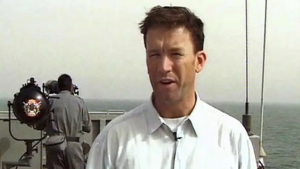Paul Moran
(journalist, propagandist, spook) | |||||||||||||||||||||||
|---|---|---|---|---|---|---|---|---|---|---|---|---|---|---|---|---|---|---|---|---|---|---|---|
 | |||||||||||||||||||||||
| Born | 30 May 1963 | ||||||||||||||||||||||
| Died | 22 March 2003 (Age 39) Iraqi Kurdistan, Iraq | ||||||||||||||||||||||
Cause of death | car bomb | ||||||||||||||||||||||
| Nationality | Australian | ||||||||||||||||||||||
| Partner | Lynn McConaughey | ||||||||||||||||||||||
| Spouse | Ivana Rapajic | ||||||||||||||||||||||
| Interests | Kurdistan | ||||||||||||||||||||||
Australian spook who worked for the Rendon Group under journalistic cover. He made a television interview for the Australian Broadcasting Corporation with an Iraqi defector that helped create the pretext for the 2003 Iraq Invasion. Died under murky circumstances.
| |||||||||||||||||||||||
Paul William Moran was an Australian spook who worked for the Rendon Group under journalistic cover. As a freelance photojournalist for the Australian Broadcasting Corporation[1][2], he made a television interview with an Iraqi defector that helped create the pretext for the 2003 Iraq Invasion, a war Moran himself became a causality in.
Background
Moran was born and raised in Adelaide.[3] His alma mater was Sacred Heart College in Adelaide. He was married to Ivana Rapajic.[4]
Career
Paul Moran was a freelance cameraman for the Australian Broadcasting Corporation. In 1990, he moved to London, and it was here that he made his initial contacts for work in the Middle East.
Moran started work for the propagandist Rendon Group, whose clients included the CIA, the Pentagon and the Iraqi National Congress (INC). Moran spent time in Kosovo in 1999 as a photographer for what he described at the time as a "human rights" website, the Balkan Information Exchange, which was being set up by the Rendon Group.
The INC, given its name by John Rendon himself, was formed just after the first Gulf War (1990-91) as a loose coalition of Iraqi and Kurdish groups opposed to Saddam Hussein, with an original purpose to gather information, distribute propaganda and recruit dissidents.[5] Moran helped to set up a television station for the INC.[6]
Moran had on behalf of the Rendon Group used his experience as a cameraman to train Kurds in photographic espionage, to covertly film Iraqi military activities.[7]
Iraqi WMD propaganda
In December 2001, Paul Moran made a television interview with al-Haideri, a defector who claimed he had worked at illegal chemical, biological and nuclear facilities around Baghdad[8]. The revelations made about the - fictitious - WMDs were aired initially by the Australian Broadcasting Corporation (ABC), another of Moran’s regular employers. Thus given credibility, the lie was then picked up spread by the rest of the world's corporate media.
Along with Judith Miller’s front page article in the New York Times about WMDs, the interview paved the way the invasion by 'proving' George Bush and Tony Blair's case, and in helping sway a significant level of public opinion in both the US and Britain in favor of the invasion[5].
Moran received the tip for the defector from Zaab Sethna. James Bamford describes how "Sethna knew he could count on the trim, thirty-eight-year-old journalist: A former INC employee in the Middle East, Moran had also been on Rendon's payroll for years in 'information operations,' working with Sethna at the company's London office on Catherine Place, near Buckingham Palace."[7]
Several things indicate that the al-Haideri propaganda interview to a large extent was an Australian intelligence operation; including the use of Australian "media" operatives, and the use of a government channel to give the interview a sheen of credibility. Al-Haideri also received asylum in Adelaide, South Australia, right afterwards.[9]
Death
Moran worked for the ABC of Australia and he was travelling from Sulaymaniyah to a base belonging to Ansar al-Islam that had been struck by US missiles on 22 March 2003.
His group just arrived at a Kurdish-controlled checkpoint in the city of Sulaymaniyah, and Moran was shooting video when a suicide car bomb exploded in a passing taxi[How?], killing Moran and injuring ABC's Eric Campbell. Three or four other people besides Moran died at the checkpoint in Khurmal and 23 others in addition to Campbell were injured.
Ansar al-Islam was accused of carrying out the car bomb attack in response to the earlier US attack.[10][11][12]
Problems around death
In is not clear how the car bomb was arranged on such short notice, or why it was necessary with a suicide attack, or if the main target indeed was Moran. The CIA has traditionally given covert support to groups like Ansar al-Islam.
The death of Moran came at a convenient time for Rendon.
In 2007, the ABC’s Freedom Of Information Coordinator Joan McKain, rejected a request for Moran’s personnel file under Section 41 (1) of the Freedom Of Information Act.[6]
The mastermind behind the attack was allegedly Mullah Krekar of Ansar al-Islam, an Iraqi Kurd living in exile in Norway.[6] Chris Warren, the Federal Secretary of the Media Entertainment Alliance of Australia (Australian Journalists Association) asked Australia's Attorney General to investigate Mullah Krekar and his links to UN-listed terrorist organisation Ansar al-Islam. The Australian Federal Police replied on request in 2007 that "At this stage the AFP has not received a formal referral concerning the death of Mr Moran and therefore has not commenced an investigation."[13]
References
- ↑ http://www.paulmoran.org/biography.html
- ↑ https://www.abc.net.au/corp/memorial/paulmoran.htm
- ↑ http://www.abc.net.au/corp/memorial/paulmoran.htm
- ↑ http://www.paulmoran.org/biography.html
- ↑ a b https://archive.is/F4KKd
- ↑ a b c https://www.scoop.co.nz/stories/WO0912/S00185.htm
- ↑ a b https://universityofleeds.github.io/philtaylorpapers/vp01ba9b.html
- ↑ https://www.mcclatchydc.com/news/special-reports/iraq-intelligence/article24463927.html
- ↑ https://www.prwatch.org/node/5509
- ↑ https://www.nytimes.com/2003/03/22/international/worldspecial/22CND-KURDS.html
- ↑ http://www.spacedaily.com/2003/030402191536.1jg2pccl.html
- ↑ https://www.theguardian.com/media/2003/mar/24/tvnews.iraqandthemedia1
- ↑ https://www.scoop.co.nz/stories/WO0912/S00185.htm